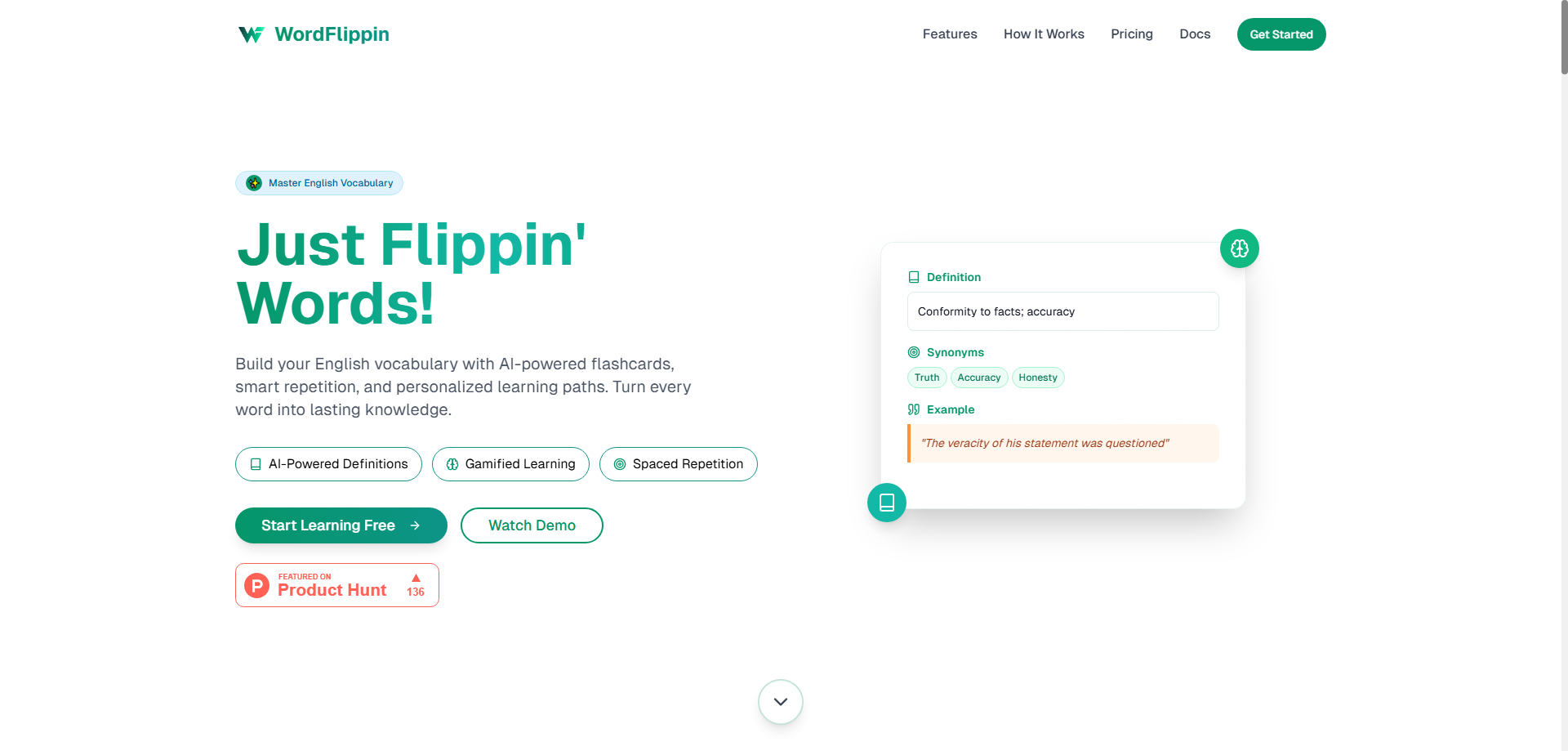1. From a Creative Perspective: Making Word Learning Feel Effortless and Fun
I’ll be honest — I’ve tried every vocabulary app out there. Flashcards, quizzes, lists — you name it. But they all had one problem: I kept forgetting the words I learned after a few days. That’s why WordFlippin feels like such a refreshing, creative twist on something as old as language learning itself.
Instead of forcing me to cram, it feels like the app actually understands my brain. Every time I learn a new word, it tracks when I’m most likely to forget it and brings it back just in time — like a friend gently reminding me, “Hey, remember this one?”
It’s powered by AI, but what makes it magical is how human it feels. It doesn’t punish you for forgetting. It adjusts, learns from you, and shapes a rhythm that fits your pace. Whether I’m prepping for an exam or brushing up for travel, I can literally feel my vocabulary growing every day — with zero burnout.
In short, WordFlippin turns vocabulary building into a creative process of self-discovery. I’m not memorizing words anymore — I’m owning them.
2. From a Disruptive Perspective: Could WordFlippin Replace Existing Learning Apps?
When I first used WordFlippin, I realized something: this isn’t just another “learn new words” app — it’s a challenge to how we think about memory itself.
Most vocabulary apps follow a static pattern — you study words, repeat them a few times, and move on. But WordFlippin uses AI-driven spaced repetition, meaning it watches how you remember (and forget) words, then customizes your learning schedule automatically.
This approach feels light-years ahead of traditional flashcard apps like Anki or Quizlet. Instead of me planning what to review, WordFlippin does it for me — perfectly timed, scientifically backed, and personalized.
Could it replace existing apps? For most learners, yes. Especially those tired of rigid systems that treat everyone the same. WordFlippin’s real disruption lies in how it integrates science and empathy — it’s not about grinding through lists; it’s about growing at your natural pace.
In an industry full of “study harder” tools, WordFlippin boldly says, “Let’s study smarter.” And that’s a revolution in itself.
3. From a Demand Perspective: Why Learners Are Embracing It (and Why I’m Hooked Too)
Here’s the thing — vocabulary learning is universal. Students, professionals, travelers, language lovers… everyone needs it. But traditional methods? They’re exhausting and ineffective.
That’s why WordFlippin is catching on fast. With 135 upvotes and a growing buzz among students and language enthusiasts, it’s clear people are craving something that actually works.
When I first started, I was skeptical — but a week later, I could recall every single word I had learned without stress. The app doesn’t overwhelm me with hundreds of new words. Instead, it curates them intelligently, reintroducing words right before I forget them. That rhythm keeps my confidence high and my anxiety low.
And it’s not just about memorizing — it’s about retaining. Professionals use it to learn industry-specific vocabulary. Travelers love it for quick, practical phrases. Students swear by it for exam prep.
In short, WordFlippin fits modern learners perfectly: busy, easily distracted, and looking for results that last. It’s not just a study tool — it’s a memory companion that understands human forgetfulness better than humans do.
4. One-Year Survival Forecast: ⭐️⭐️⭐️⭐️⭐️ (5 out of 5 Stars)
If I had to predict the future, WordFlippin isn’t just going to survive — it’s going to dominate.
⭐️⭐️⭐️⭐️⭐️ (5 out of 5 stars)
Opportunities:
- Growing global demand for language learning: Millions are learning English, Spanish, or other languages — and WordFlippin directly addresses the biggest pain point: retention.
- AI-driven personalization: It’s ahead of the curve in using artificial intelligence to adapt to each learner’s unique memory curve.
- Neuroscience-backed credibility: By leveraging the proven spaced repetition method, it builds trust among both educators and self-learners.
- Multi-use flexibility: Students, travelers, professionals — everyone can use it for their own purpose, widening its appeal.
Risks:
- Competitive landscape: Big players like Duolingo and Memrise have massive user bases. WordFlippin must market its retention-first advantage clearly.
- Monetization challenge: If it remains free for too long, scaling could be tough. But paid models risk losing casual users.
- Overreliance on AI tuning: It needs constant fine-tuning to ensure its algorithms stay accurate and engaging for diverse users.
Even with these challenges, WordFlippin’s edge is undeniable. Its combination of cognitive science, AI precision, and emotional intelligence makes it stand out in a crowded market.
If it keeps evolving — adding features like pronunciation tracking, gamified learning, or community challenges — it could easily become the most effective vocabulary app of the next year.
Final Thoughts
For me, WordFlippin is more than just a vocabulary app — it’s a rethinking of how humans learn.
It’s creative, it’s scientifically grounded, and it’s deeply personal. It doesn’t make me feel like I’m studying; it makes me feel like I’m progressing. Every time I master a new word, it’s a tiny victory that sticks — and that feeling is addictive.
In a world full of flashy but shallow learning apps, WordFlippin brings substance back to the table. It helps me build not just a bigger vocabulary, but a lasting one.
So if you’ve ever felt frustrated by how quickly new words slip away, do yourself a favor — give WordFlippin a try. It doesn’t just teach you words. It teaches your brain how to remember them.









